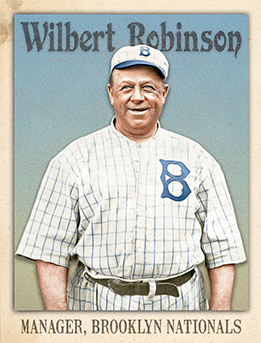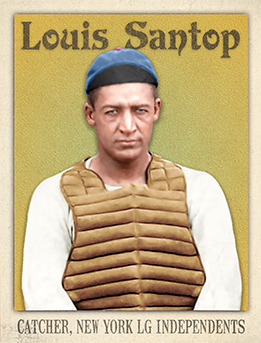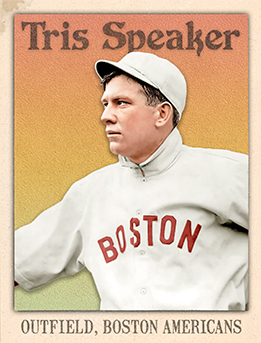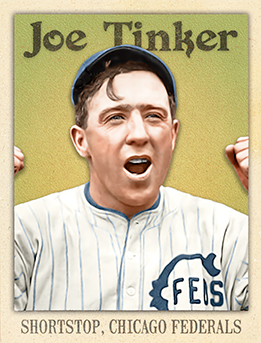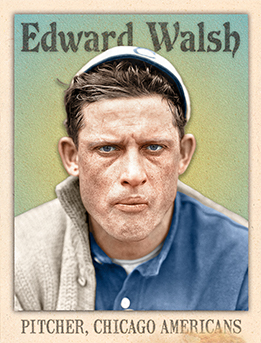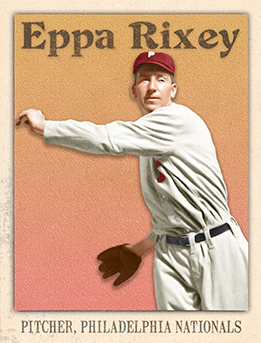
- Series: Diamond Heads '15
- City: Philadelphia
- Team: Phillies
- League: National League
- Hall: National Baseball Hall of Fame
Eppa Rixey, Jr. (1891-1963) was one of the most durable left-handers of all-time. Until 1959 he was the NL’s winningest southpaw. That year, Warren Spahn surpassed Rixey and for the first 60 years of the century, only Walter Johnson and Pete Alexander started more games. The pitcher never played a day in the minors thanks to his University of Virginia coach’s rave reviews. Cy Rigler was a well-regarded umpire when not mentoring college players so his scouting report counted and the Phillies responded, signing him for the 1912 season. The club won a pennant in 1915 but Rixey labored for a mostly sub-par team until traded to the Reds in 1921. Rixey’s debut season with Cincy was stunning, allowing only one HR in 301 innings en route to a league-leading 25 wins. Staying with the Reds through 1933, Rixey’s labors for two lower division franchises meant the losses added up, too. So much so that he owns the dubious record of most losses in a career for a lefty: 251.
- The hard-working, likable southerner lived just long enough to learn of his selection to Cooperstown, exclaiming to his family “I finally made it!”
- Elected to Hall of Fame: 1963
- Series: Diamond Heads '15
- City: Brooklyn
- Team: Robins
- League: National League
- Hall: National Baseball Hall of Fame
Uncle Robbie (1863-1934). A durable catcher for 17 seasons with 3 teams, Robinson is credited as the 1st to play directly behind the plate at all times. Uncle Robbie once caught 5 games in two days. He also had 7 hits & 11 RBI in a single game. After his playing days were over, Robinson went on to manage for 18 seasons.
- Won 3 NL pennants as player
- Won 2 NL pennants as manager
- Won 5 NL pennants as pitching coach
- Elected to Hall of Fame: 1945
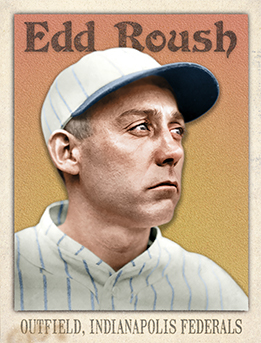
- Series: Diamond Heads '15
- City: Indianapolis
- Team: Hoosiers (FL)
- League: Federal League
- Hall: National Baseball Hall of Fame
Edd J. Roush (1893-1988) was an Indiana farm boy who knew his own mind. He built a Hall of Fame career on doing things his way. Spring training? Not for Edd, he stayed in shape. Use a bat heavier than any other player? Why not? His farm-bred arm strength allowed him to hit the ball wherever he chose with the weight of the bat doing most of the work. Stand still in the box awaiting the pitch? Not for Edd. He'd move his feet after the ball left the pitcher's hand, positioning himself according to his read. Endure management's miserly ways? No, Edd would hold out every year for a fairer contract. He'd skip to pirate leagues (the Federals) if necessary to find a better salary, something he had done as a school-boy player in Hoosier country and continued throughout his long and storied major league tenure. It took a few years in the bigs and a curious impatience by renowned manager John McGraw to get Edd to Cincinnati and the stage on which he would set records. Twice he edged out Rogers Hornsby for batting titles. He led the Reds to the Series championship in 1919, only to have that accomplishment tarnished by scandal. There is little doubt he was right in asserting that his club was better than Chicago's and really won it fair and square. During his twelve years with the Reds, Roush's batting average was .331. He never struck out more than 25 times in a season. He was fast on the bases and a terror in center, regarded as perhaps the premier defender of the Dead Ball era with Tris Speaker the competition.
- McGraw sent young Edd from the Giants to Cincy in 1916 along with two other future Hall-of-Famers: Bill McKechnie and Christy Mathewson. Matty was tickled to get a manager position and Edd and Bill were thrilled to get out from under the tough taskmaster McGraw
- When Edd threw out the ball at the last game played at Crosley Field, Joe Morgan said Roush was “the best of us all.”
- Elected to Hall of Fame: 1962
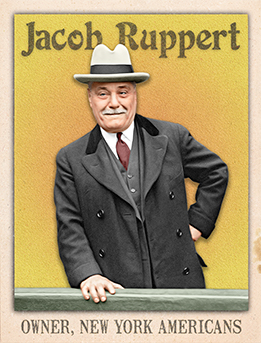
- Series: Diamond Heads '15
- City: New York
- Team: Yankees
- League: American League
- Hall: National Baseball Hall of Fame
Jacob Ruppert Jr. (1867-1939) became the 304th inductee into Baseball’s Hall of Fame in 2013, remedying an oversight many assumed had already been handled. This beer & real estate baron, National Guard Colonel & US Congressman took a second-rate NY franchise, hired Miller Huggins to manage it, saw that the mighty southpaw up in Boston had more potential at the plate than on the mound, built Yankee Stadium and tailored it to Ruth’s swing, hired the likes of Gehrig, DiMaggio and a clutch of other future Hall of Famers, and won the franchise’s first 10 pennants & 7 World Series titles. In all, Ruppert created the most storied sports organization in history and forever changed the game as the Dead Ball gave way to the Lively Ball. He died five months before there was a Hall in Cooperstown and now, just 74 years later, he’s in it.
- Was instrumental in creating the office of Commissioner and hiring Landis as czar in 1920
- Initially fought to rename the Yankees as theKnickerbockers after his family’s flagship brew
- Elected to Hall of Fame: 2013
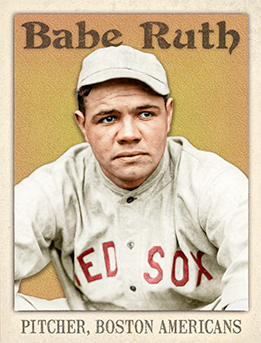
- Series: Diamond Heads '15
- City: Boston
- Team: Red Sox
- League: American League
- Hall: National Baseball Hall of Fame
George Herman Ruth, Jr. (1895-1948) is the Colossus of modern baseball. As pitcher and hitter, Ruth dominated his times as no other athlete, leading his teams to 10 World Series’ appearances and 7 titles in 22 years, winning all three World Series games he pitched with a .87 ERA and belting 15 home runs with a .326 average and 1.214 OPS across his 41 World Series’ games. He rewrote the record book, including most prodigious clouts ever: 575’ in Detroit and the longest HR out of Forbes Field in its 60 year history (his last ML hit). A complex man and player, not all Ruth’s achievements covered him in glory: only man to end a Series by being caught stealing (’23); ejected after walking first batter, giving way to Ernie Shore who allowed no others to reach base; refusing to play the “sun field” after one dropped fly. But oh the hitting! It took Mickey Mantle 18 years at the Stadium to match Ruth’s HRs in 12.
- The Babe was Gargantua incarnate: crude, ferocious, primitive and bigger than life. And also forever young, with a magnificent heart and generous spirit. The Icon of the Age
- Elected to Hall of Fame: 1936
- Series: Diamond Heads '15
- City: New York
- Team: Lincoln Giants
- League: Independent
- Hall: National Baseball Hall of Fame
Louis Santop (Loftin) (1890-1942) was a prodigious HR slugger & indomitable catcher in the Negro Leagues. He averaged .406 lifetime, caught two of the hardest throwing pitchers of all-time (Smokey Joe Williams & Dick Redding) and endured behind the plate for an astonishing 15 seasons despite the privations and rigor of black baseball in America in his day. A jovial giant, Top was a fan favorite & sure-fire draw with his ability to throw a ball over outfield fences before games & hit it even further during games.
- It is told the Newark park had an ad promising a suit to players who hit the 440’ centerfield fence. The sign was removed after Santop hit it three times in one game
- Played for great Negro League teams including the NY Lincoln Giants and the Hilldale Club
- Elected to Hall of Fame: 2006

- Series: Diamond Heads '15
- City: Washington, D.C.
- Team: Senators
- League: American League
Herman A. Schaefer (1876-1919) was the Clown Prince of baseball for nearly two decades in the early years of the last century. “Germany” (or “Liberty” as he thought a better nickname after WWI began) was beloved for his antics on the field. In its obituary, the New York Times said he was “one of the most popular figures on the diamond.” Born into the tough German immigrant district of south Chicago, the stocky Schaefer came up through semi-pro ball and soon made it to the Cubs in late 1901. A slump the following year sent him to the PCL and other minor league teams before the Tigers brought him back to the bigs in '05. Legends surrounded the colorful Schaefer and it is hard to tell fact from fiction. He was said to have called shots long before the Babe, make dramatic self-narrated trips around the bases and harangue mercilessly some of the greats of his day. One of his most storied feats involved his famed steal of first, accomplished from second base in order to tempt a run-scoring errant throw. After his death, baseball officially outlawed such depredations. John McGraw hired Schaefer as a scout in 1919 but the bantam joker succumbed to a TB-induced hemorrhage on a train trip to check on NY talent.
- Germany played for six MLB teams including the Federal League's Newark Peppers. He closed his career with Cleveland months before his untimely death
- His lifetime .257 average belied his ability to deliver clutch hits, seemingly at will, when the moment was right
- A Detroit sportswriter effused: “Germany Schaefer was the soul of baseball itself, with all its sorrows and joys, the born troubadour of the game.”

- Series: Diamond Heads '15
- City: Chicago
- Team: White Sox
- League: American League
- Hall: National Baseball Hall of Fame
Raymond William Schalk (1892-1970) was too boyish and too small for the cop at Comiskey Park to believe he could be a ballplayer. But what Schalk lacked in physical stature he more than made up in energy, determination and innate talent. He redefined the role of the ML catcher, starring for the White Sox from 1912 through 1928 en route to the Hall of Fame. Along the way, Schalk proved that catchers can steal bases, they can make double-plays, they can back-up at every base. And Schalk didn’t merely field his position better than the others of his era, he had a gift for working with pitchers. He caught four no-hitters including a 1922 perfect game. And he knew something was wrong when his best mates wouldn’t throw what he called for in the ’19 Series. Absolved of any complicity, Schalk went on to be player-manager of the team.
- Still holds records at his position, including 11 straight years catching over 100 games
- Only Yogi Berra and Carlton Fisk caught more shut-outs
- Elected to Hall of Fame: 1955

- Series: Diamond Heads '15
- City: Chicago
- Team: Cubs
- League: National League
Frank M. Schulte (1882-1949) played for his local minor league franchise, the New York State League’s Syracuse Stars, for three years before being discovered by the National League’s Chicago club, who bought his contract and brought him up at the end of the 1904 season. The team was being called the “Cubs” by sportswriters, a name that wouldn’t be official until 1907. By any name, “Wildfire” Schulte made a big impact. He was a solid-hitting outfielder who became a mainstay in West Side Park's outfield as the Cubs won four pennants and two World Series during his long tenure. Frank must have really liked the play “Wildfire” he once saw in Mississippi: He named his racehorse after the play and would earn the sobriquet for himself by teammates who clearly appreciated his spirit.
Schulte’s above average hitting (career 115 OPS+) was reliable, but he proved particularly clutch in the post-season, where he averaged .321 across 21 World Series' contests. Such fortuitous timing would further Schulte's legacy in yet another remarkable achievement: his spectacular campaign of 1911 just-so-happened to coincide with the inaugural presentation of the Chalmers Award; essentially MLB's very first MVP award, which was gifted to the "most important and useful player to the club and to the league." The prior season, Hugh Chalmers decided to spark car sales for his automotive company by offering a new model to the players with the highest batting averages in each league. The ensuing fiasco involving Ty Cobb and Nap Lajoie prompted Chalmers to revise the award in 1911 to be gifted to the leagues' “MVPs” and Schulte's career year-for-the-ages couldn't have been better timed.
Schulte’s 1911 MVP Award season:
- 154 games, 105 runs, 173 hits, 30 doubles, 21 triples, league-leading 21 HR, 107 RBI, 23 stolen bases, league-leading .534 slugging, league-leading OPS+ 156, league-leading 308 total bases
- With the performance, Schulte became the first person in MLB history to have 20 or more doubles, triples, home runs and stolen bases in the same season
- Schulte's achievement would stand unmatched for 46 years, until Willie Mays duplicated the feat in 1957
- Schulte earned his nickname by a ferocious approach to base running that saw him steal home 22 times
- Famed shortstop Joe Tinker’s Chicago career spanned Wildfire’s and Schulte inspired Tinker to speculate that no “quainter or more original character ever existed in the National Pastime.” One eccentricity was Schulte’s penchant for scouring the sidewalks looking for hairpins, auguring success at the plate.
- Another testimony to Frank’s batting prowess was his thirteen-game hit streak during his four World Series appearances, which still ranks him fourth all-time, tied with Harry Hooper and Derek Jeter
- Schulte closed out his time in Chicago with the 1916 season. He spent the next three years with three teams and went on to play in the International League and Pacific Coast League through 1922 before retiring to live in Oakland, CA
For a brief but wonderful account of the history of the Chalmers Award, including a review of the events of 1910 surrounding the controversy between Ty Cobb & Nap Lajoie, check out this Ars Longa guest blog post by Van Nightingale: Did They Get it Right?
- This card is not included in the 100-card Diamond Heads '15 base set.
- This card is one of the rewards you receive for completing the Ars Longa Clubhouse Challenge: Chalmers Awards Winners
- This card is exclusive to that challenge, is gifted freely to winners of the challenge, and is neither bartered nor sold otherwise by Ars Longa.
- This is one of two such Diamond Heads '15 Clubhouse Challenge reward cards. The other is Franklin Pierce Adams.
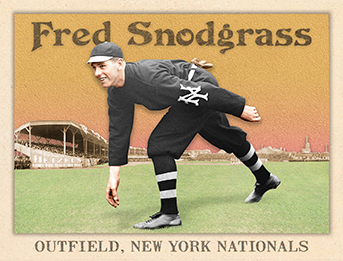
- Series: Diamond Heads '15
- City: New York
- Team: Giants
- League: National League
Frederick Carlisle Snodgrass (1887-1974) broke into MLB with the Giants in ’08 and became a mainstay in the outfield by virtue of his speed & hitting. As proficient as he was at bat & on base, Snodgrass spent his career mired in controversy, especially on the big stage of the World Series: intentionally spiking Frank Baker, dropping a fly ball & later bringing down the house in Fenway after defiantly challenging the home folks. That incident prompted Boston’s mayor (“Vote often and early for James Michael Curley”) to stride on field and demand Snodgrass’ ouster. Fittingly, Fred was traded to the Bosox the next season.
- Haunted throughout his life by the 1912 Series gaff, Snodgrass was spared the indignity of reading the headline on his NY Times obituary: “Fred Snodgrass, 86, Dead; Ball Player Muffed 1912 Fly.”
- Harry Hooper, Boston’s fleet slugger, was robbed by Snodgrass on the next play. Hooper always defended Snodgrass, citing numerous other miscues that led to the Giants’ loss that day
- Series: Diamond Heads '15
- City: Boston
- Team: Red Sox
- League: American League
- Hall: National Baseball Hall of Fame
Tristram E. Speaker (1888-1958) enjoyed a long and storied career as perhaps the greatest all-around center fielder in the game. Led the Red Sox to two titles and, upon moving to Cleveland over a salary dispute, led the Indians to a championship in 1920. He still holds MLB records for doubles and outfield assists.
- Career batting average: .345
- Also still holds MLB record for unassisted double plays by an outfielder
- Speaker’s glove came to be known as “the place where triples go to die”
- Elected to Hall of Fame: 1937
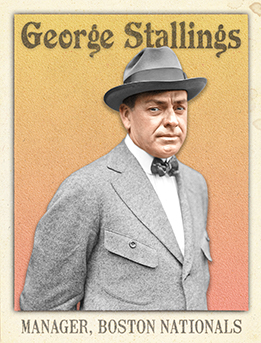
- Series: Diamond Heads '15
- City: Boston
- Team: Braves
- League: National League
George Tweedy Stallings (1867-1929) got two hits in his 20 major league at bats. He managed the Phillies to 74 wins and 104 defeats in his first two years as pilot of a big league team. He did a bit better with Detroit and NY when he joined the American League but would end his career as field general with a mediocre sub-.500 record. So why is this fellow known as the “Miracle Man?” He left the Highlanders for Boston in 1913 and brought signs of life to Beantown’s beleaguered Braves. They rose to a fifth place finish after bottoming out each of the previous four years. But, oh what joy 1914 would bring. That season started as dismally as usual for a Stallings-led squad. On July 15 the Braves trailed the Giants by 11 ½. Suddenly the stars aligned. Boston would end that regular season by gaining 22 games on NY. They rode their 10 ½ game lead into the Series with the Athletics and swept them in four. The team would forevermore be the “Miracle Braves” and George earned the nickname he carried the rest of his life.
- Bill James credits Stallings with being the first to deploy platooning as an offensive tool rather than a cover for weakness
- The Georgia native went on to reestablish baseball in Montreal and, with his partners, built the stadium where Jackie Robinson prepped for his historic debut in Brooklyn in ‘47

- Series: Diamond Heads '15
- City: Brooklyn
- Team: Robins
- League: National League
- Hall: National Baseball Hall of Fame
Charles Dillon Stengel (1890-1975) played and managed over half a century, seeing the game go from the Dead Ball Era to “Can’t anybody here play this game?” Casey broke in with Brooklyn in 1912, then the Pirates, Phillies, Giants and Braves, compiling a respectable .284 BA with 60 HRs. Stengel won the Giants’ two Series victories in ’23 with home runs. But it was not as a player that Casey entered the Hall of Fame. He managed his way to Cooperstown riding 1905 lifetime wins at the helm of the New York clubs and Boston from ’34-’65. He played for one world-title team and managed 7 more. The venerable and voluble manager became a fount of baseball wisdom and humor, endearing him to generations of fans.
- Only man to wear the uniforms of the 4 NY clubs
- Came out of retirement to helm the hapless Mets through their painful early years, giving the Old Perfessor “new ways to lose I never knew existed before.”
- Elected to Hall of Fame: 1966
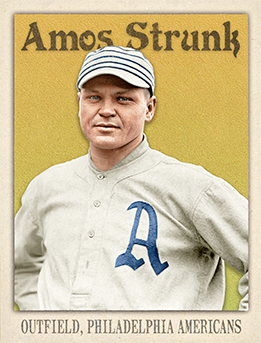
- Series: Diamond Heads '15
- City: Philadelphia
- Team: Athletics (AL)
- League: American League
Amos Aaron Strunk (1889-1979) was added to Connie Mack’s growing assemblage of speedy players in 1908 and then sent to Milwaukee to get major-league-ready. In and out with injuries (much of his career) Strunk began to shine on defense. By 1913 he was touted as the best defender of all-time. In ‘16 Baseball Magazine proclaimed him to be in the company of Cobb and Speaker. Mack witnessed Strunk’s contributions to three national championships, 1911, 1913, and 1914, read the reviews and still said Strunk was underrated. Sold to Boston when Mack was rebuilding, Amos couldn’t adjust to Beantown despite another title and returned to the Athletics in 1919. After another stint with the White Sox, Mack got his prized centerfielder back one final time in 1924 but the toll of too many outfield collisions brought an end to a 17-year career where the left-hander compiled a .284 average. Never a big base-stealer, Strunk was among the best at advancing on the basepaths. Mack’s famed “double squeeze play” owed much to Strunk’s ability to get a jump from second and score right behind the runner who had been at third when the bunt got down.
- Strunk lived to see 90, having spent over half a century in the insurance business following his retirement from the game

- Series: Diamond Heads '15
- City: New York
- Team: Giants
- League: National League
James Francis Thorpe (1888-1953) grew up in the Sac and Fox nation in Oklahoma, a hardscrabble existence that saw him in and out of boarding schools. Orphaned and troubled, the teenager found himself in faraway Pennsylvania and came under the tutelage of the renowned Pop Warner. Thorpe’s athletic skill would carry him to heights few have attained, a Renaissance man of sport, bestride the 20th Century. Acclaimed as the world’s greatest athlete in the 1912 Olympics where Thorpe played in two exhibition baseball games, presaging a professional career. A rare “free agent” in the era of the reserve clause, he was able to choose the Giants over the last-place Browns during the 1913 season. He played sporadically but went to the World Series and was the star of the global tour of Giants/White Sox players that off-season.
- Team owners caromed Thorpe from team to team with limited playing time, ending his MLB tenure with the Boston Braves in 1919
- Hit the ball that Hippo Vaughn misplayed, ending the remarkable “double-no-hitter” in 1917
- Series: Diamond Heads '15
- City: Chicago
- Team: Chi-Feds
- League: Federal League
- Hall: National Baseball Hall of Fame
Joseph Bert Tinker (1880-1948) sparkled at short, helping the Cubs to 4 pennants and 2 Series wins. He and fellow rookie Johnny Evers turned their first double-play to Frank Chance on Sep 13, 1902. A fight over a cab ride left Tinker and Evers estranged for years, but didn’t prevent them from playing 2nd “like one man, not two.” Tinker was widely held to be second only to Honus Wagner at SS, leading the league in many fielding categories. As skilled as he was afield, Tinker was also one of the great clutch hitters. Christy Mathewson deemed him the NL player he least wanted to see.
- On June 28, 1910 Tinker became one of a handful to steal home twice in a game
- Asked to leave the Cubs when Evers was made manager in 1913 but filled that role himself after a hiatus with the Federal League
- Elected to Hall of Fame: 1946
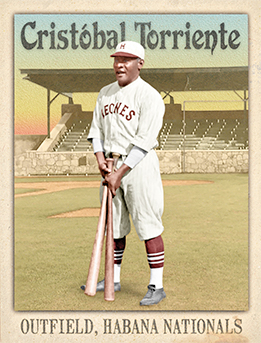
- Series: Diamond Heads '15
- City: Havana
- Team: Leones
- League: Cuban National League
- Hall: Cuban Baseball Hall of Fame, National Baseball Hall of Fame
Cristobal Torriente (1893-1938) had the Babe Ruth build (stocky with spindly, slightly bowed legs) and, more than that, he had a Ruthian swat. He punched his ticket to the Hall of Fame by starring in Cuba and America’s Negro Leagues. In 1920 he was dubbed the “Black Babe Ruth” during an off-season exhibition against Torriente’s Almendares club versus the New York Giants who brought the Babe along. Per his Cooperstown plaque, Cristobal outhit and out-homered the Sultan of Swat over the nine game series, earning a nickname for the ages. Like the best Cuban players, Torriente had been playing at home and in the States for black franchises since 1913. He soon caught the attention of J. L. Wilkinson who signed him for the “All Nations” squad for several years. He helped lead the Chicago American Giants to the first three pennants in the Negro League. The left-handed batter (the Ruth parallels just kept coming) not only hit for power but was often around .400. Fleet of foot (sorry Babe) Torriente was a marvel in the outfield despite his physique and he had a great arm. A rival manager, C.I. Taylor, once remarked “If I see Torriente walking up the other side of the street, I would say, ‘There walks a ballclub.’” He averaged .344 over a long career in black baseball and set the Cuban Winter Leagues record at .350 overall.
- Sadly there was another way in which Torriente patterned himself after Ruth. He loved the nightlife and frequently over-indulged which led to fights with umpires and management. His alcoholism took a dire toll, plunging the slugger into poverty where he fell victim to tuberculosis and an all-too-early death at 44
- The Cuban Hall of Fame was inaugurated a few weeks after Cooperstown’s. Torriente was among the initial class of ten in 1939
- Elected to Hall of Fame: 2006
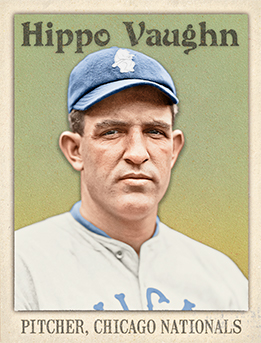
- Series: Diamond Heads '15
- City: Chicago
- Team: Cubs
- League: National League
James Leslie Vaughn (1888-1966) threw to his catcher for an easy out in the tenth inning of a game against Cincinnati one cold afternoon in Chicago. The catcher stood with his hands at his side, the ball bounced off his chest protector and Hippo’s no-hit bid ended, along with the ballgame. The opposing pitcher, Fred Toney, recorded three more outs to get his own no-hitter. Vaughn’s response after such a curious debacle?: “…I wasn’t sore, I’s just lost another ballgame, that’s all.” Clearly Vaughn shed any disappointment as he went out the next season and led the Cubs and the league, winning the “triple crown” for pitchers. Hippo was one of the premier hurlers in baseball over a six year span but his loss to the Reds in the game’s only “double-no-hitter” will forever leave an indelible mark.
- Recorded five 20-win seasons en route to 178 career victories
- Pitched for NY 1908-12, Washington in 1912 and the Cubs from 1913-1921
- No one knows how this strong 6’4” 215 lb workhorse acquired the unflattering nickname
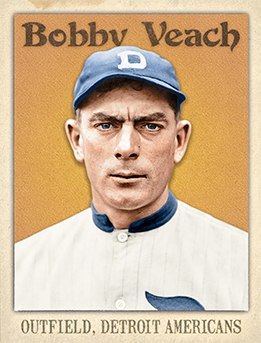
- Series: Diamond Heads '15
- City: Detroit
- Team: Tigers
- League: American League
Robert Hayes Veach (1888-1925) took over in left field at Navin Field in Detroit on Sept 6, 1912 and held that post until 1924 when the Tigers traded him to the Red Sox. In his decade-plus as wingman to Ty Cobb, along with Harry Heilmann and Sam Crawford, Veach was part of the most potent outfield in history. Many, including Bill James, peg the 1915 Tigers’ outfield the best of all-time. Because he played somewhat in the shadow of these greats, and perhaps because the Tigers never won a World Series, this veteran with a lifetime .310 average and top-of-the-league production at the plate and in left, never made it to Cooperstown. As good as he was before the war years, 1919 was Veach’s pinnacle. He led the AL in hits, doubles and triples. Only Cobb bested his .355 average and only Ruth topped his 101 RBI and 279 total bases. In 1920 Veach became the first Tiger to hit for the cycle. From 1915 to 1922, nobody drove in more runs or had more extra-base hits than Bobby Veach.
- Playing for the Yankees in his final season, on Aug 9, 1925, Bobby pinch-hit for Ruth, the first time that had happened since Babe left the mound
- Veach ended his dazzling ML career with pennant-winning Washington that same year
- Series: Diamond Heads '15
- City: Pittsburgh
- Team: Pirates
- League: National League
- Hall: National Baseball Hall of Fame
Johannes Peter Wagner (1874-1955) was, simply, the greatest shortstop who ever played the game. The Pittsburgh icon was among the first five selections to Cooperstown in 1936 in recognition of overall prowess afield, at bat and on base unparalleled in baseball. Even his closest rival for “All-Time Best” honors, Ty Cobb, said Honus was “maybe the greatest star ever to take the diamond.” Badgered mercilessly by ‘Nuf Ced’ McGreevy’s Royal Rooters in the ’07 Series with Boston, Wagner was deeply wounded by his mediocre performance. He achieved some vindication 2 years later, leading the Pirates over Cobb’s Tigers.
- Space doesn’t allow a fair summary of Wagner’s hitting records. A marvel at the plate.
- A Pirates’ coach for 39 years, Hans mentored several future Hall of Famers
- Elected to Hall of Fame: 1936
- Series: Diamond Heads '15
- City: St. Louis
- Team: Browns (AL)
- League: American League
- Hall: National Baseball Hall of Fame
Rhoderick John Wallace (1873-1960) had a Hall of Fame career as one of the top shortstops for 24 years before going on to one of the longest tenures in MLB as coach, manager, scout and even a short stint as an umpire. Playing primarily in St. Louis for the Cardinals and Browns, Wallace set records, including a mournful one: longest career by a player to never make the World Series.
- Too good a fielder to stay on the mound, became the premier defensive SS of his era
- In 1911, Pirates’ owner declared Wallace the one player in the AL he desired above all others
- Elected to Hall of Fame: 1953
- Series: Diamond Heads '15
- City: Chicago
- Team: White Sox
- League: American League
- Hall: National Baseball Hall of Fame
Edward Augustine Walsh (1881-1959) still holds the ML record for ERA with 1.82 lifetime and hurled himself into the Hall of Fame as one of the most dominant and durable pitchers of the early 20th century. He needed a year off in 1913 but felt the White Sox needed him more. He ruined his arm and effectively ended his career demanding more of that right arm than it could give after 195 wins and 1,736 SOs.
- Reputed to have guided the owner’s architect into shaping the AL park to Walsh’s liking, making Comiskey Park a “pitcher’s park” for 80 years
- Earned “workhorse” status with an average of 395 innings per season 1907-1912
- Elected to Hall of Fame: 1946
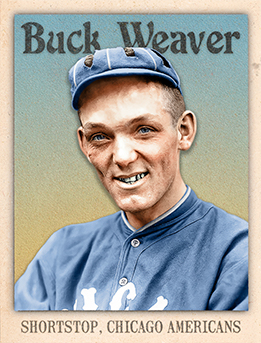
- Series: Diamond Heads '15
- City: Chicago
- Team: White Sox
- League: American League
George Daniel Weaver (1890-1956) climbed to a lofty height during his baseball career and plummeted to an historic low that would test any man. Buck’s dad insisted he forego his mother’s funeral to begin his pro career in the White Sox system. He ended his career when Judge Landis banished him from the game along with 7 fellow Sox. In between, this gregarious, cheerful soul basked in the shadows of the Great Pyramid sporting a fez during the 1913 world tour and danced for joy after Comiskey’s club locked up the ’17 Series, a team he had led in batting and afield. Although pilloried with his teammates for throwing the 1919 Series, Weaver played errorless ball, hit .324, and was never accused of taking money. He would spend the rest of his life trying to clear his name. After Cicotte and Jackson confessed, the Sporting News headlined: “Chicago Fans Grieve Most for Weaver and Still Hope for Him.”
- Played exclusively for the White Sox (1912-1920), averaging .272, and was the only banned player to remain in Chicago
- Buck successfully sued his penurious owner for his 1921 salary
- Series: Diamond Heads '15
- City: Brooklyn
- Team: Robins
- League: National League
- Hall: National Baseball Hall of Fame
Zachariah Davis Wheat (1888-1972) starred in left field for the Brooklyn Superbas/Robins/Dodgers and still holds team bests in hits, doubles, triples, RBI and total bases. Wheat defied the Deadball trend of choking up on the bat, swinging away with a “smashing swipe” according to one reporter. Yet, his stylish fielding drew the most praise (“the finest craftsman of them all.”)
- 5 of his 9 HRs in 1914 were over the fence, rare in that era
- Again defying tradition, used a light (40oz) bat and a wrist-snap unheard of then
- Survived long enough to see the lively ball, hitting .357 at age 37
- Elected to Hall of Fame: 1959
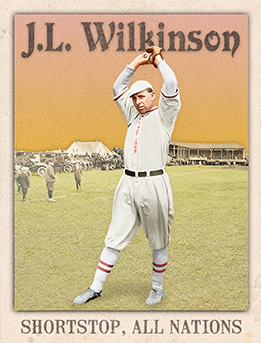
- Series: Diamond Heads '15
- Team: All Nations
- League: Independent
- Hall: National Baseball Hall of Fame
James Leslie Wilkinson (1878-1964) loved to play baseball and he loved to see everyone play the game. He organized women’s teams, black and Cuban teams, and the multi-hued All-Nations team. He barnstormed with the House of David and brought night baseball to the heartland. His KC Monarchs sent more black players to the majors than any other Negro League club and eleven of his players are in Cooperstown. Being the sole white owner in the black circuits may have seemed an unlikely role for this modest Midwesterner, but “Wilkie’s” integrity and fairness earned the trust of Rube Foster when he organized the NNL in 1920. Few men of any background have left the legacy that Wilkinson established.
- Won 17 titles and two Colored World Series
- An inveterate entrepreneur and showman, Wilkie brought the joy of America’s game to all of America thru the Roaring Twenties, the depths of Depression, and the darkness of WWII
- Elected to Hall of Fame: 2006

